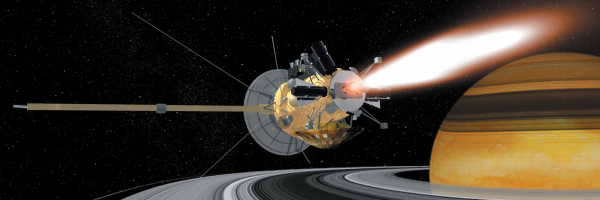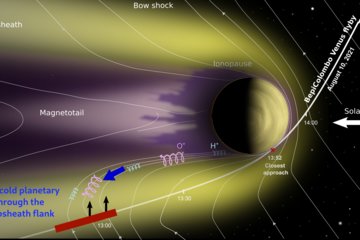
Cassini/Huygens
The CASSINI mission is named after the french astronomer Giovanni Domenico Cassini (1625-1712) who discovered 4 moons of Saturn and the ring system in the 17th century. CASSINI is a joint effort of NASA, ESA and the Italian space agency ASI. It consists of an orbiting spacecraft (CASSINI ORBITER) and a probe (HUYGENS PROBE) which has been delivered to Saturn's moon Titan. The probe is named after the dutch physicist and astronomer Christiaan Huygens (1629-1695).
Cassini was successfully launched onboard a TITAN IV B rocket from Cape Canaveral on October 15, 1997, 08:43 UT. After a journey of seven years it finally reached Saturn in July, 2004 after gravity assists from Venus, Earth and Jupiter.
Since 2004 the spacecraft orbited around Saturn and extended the knowledge of Saturn's magnetosphere, the rings, the moons and the planet itself significantly.
Cassini performed close flybys at Titan (127), Enceladus (23), Dione (5), Rhea (4), Phoebe (1), Tethys (1), Hyperion (1), Iapetus (1), Helene (1), Epimetheus (1).
The last phase of the mission started in November 2016 with the so called 22 F-ring orbits followed by the 22.5 Proximal Orbits from April 2017. The mission ended on 15 Sep 2017 when Cassini was directed into Saturn's atmosphere.
Cassini was the second largest spacecraft after Galileo which was ever launched by NASA. More than half of the total mass was fuel to carry out maneuvers in interplanetary space and in Saturn's magnetosphere.
- height: 6.7m
- weight: 5630 kg
- diameter: 4m
Scientific Payload
| Cassini Orbiter |
|---|
| Titan Radar Mapper (RADAR) |
| Imaging Science Subsystem (ISS) |
| Radio Science Subsystem (RSS) |
| Visual and Infrared Mapping Spectrometer (VIMS) |
| Composite Infrared Spectrometer (CIRS) |
| Cosmic Dust Analyser (CDA) |
| Radio and Plasma Wave System (RPWS) |
| Plasma Spectrometer (CAPS) |
| Ultraviolet Imaging Instrument (UVIS: |
| Dual Technique Magnetometer (MAG) |
| Ion and Neutral Mass Spectrometer (INMS) |
| Huygens Probe |
| Aerosol Collector Pyrolyser (ACP) |
| Doppler Wind Experiment (DWE) |
| Gas Chromatograph and Mass Spectrometer (GCMS) |
| Huygens Atmospheric Structure Instrument (HASI) |
| Surface Science Package (SSP) |
Titan
 Titan is Saturn's largest moon and orbits the planet at a distance of about 20 Rs. Remarkable is the dense atmosphere that mostly consists of nitrogen (98 %). The Cassini spacecraft has performed more than 100 flybys and revealed some of the mysteries about this interesting moon. It's long known that Titan is the only moon in the solar system that has an atmosphere and scientists speculated about the possibility of liquids on the surface. The thick haze layers preclude the view in visible light.
Titan is Saturn's largest moon and orbits the planet at a distance of about 20 Rs. Remarkable is the dense atmosphere that mostly consists of nitrogen (98 %). The Cassini spacecraft has performed more than 100 flybys and revealed some of the mysteries about this interesting moon. It's long known that Titan is the only moon in the solar system that has an atmosphere and scientists speculated about the possibility of liquids on the surface. The thick haze layers preclude the view in visible light.











